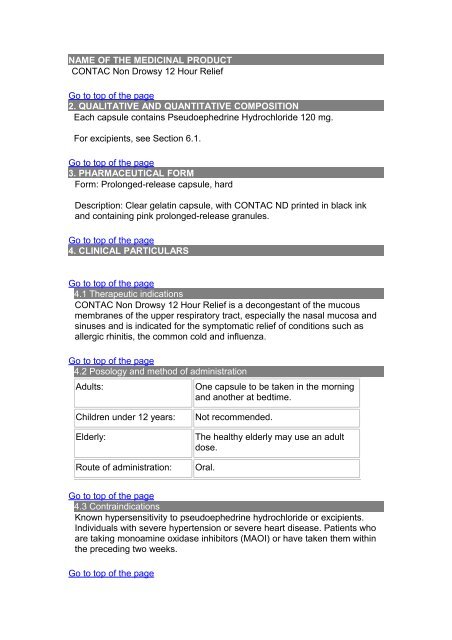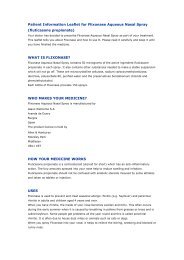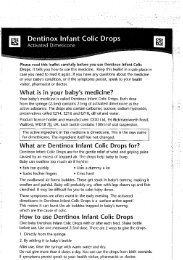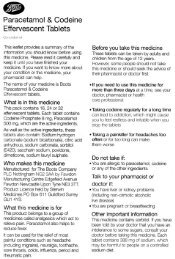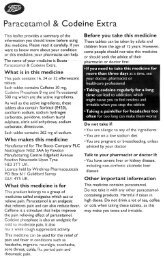NAME OF THE MEDICINAL PRODUCT - Boots
NAME OF THE MEDICINAL PRODUCT - Boots
NAME OF THE MEDICINAL PRODUCT - Boots
Create successful ePaper yourself
Turn your PDF publications into a flip-book with our unique Google optimized e-Paper software.
<strong>NAME</strong> <strong>OF</strong> <strong>THE</strong> <strong>MEDICINAL</strong> <strong>PRODUCT</strong><br />
CONTAC Non Drowsy 12 Hour Relief<br />
Go to top of the page<br />
2. QUALITATIVE AND QUANTITATIVE COMPOSITION<br />
Each capsule contains Pseudoephedrine Hydrochloride 120 mg.<br />
For excipients, see Section 6.1.<br />
Go to top of the page<br />
3. PHARMACEUTICAL FORM<br />
Form: Prolonged-release capsule, hard<br />
Description: Clear gelatin capsule, with CONTAC ND printed in black ink<br />
and containing pink prolonged-release granules.<br />
Go to top of the page<br />
4. CLINICAL PARTICULARS<br />
Go to top of the page<br />
4.1 Therapeutic indications<br />
CONTAC Non Drowsy 12 Hour Relief is a decongestant of the mucous<br />
membranes of the upper respiratory tract, especially the nasal mucosa and<br />
sinuses and is indicated for the symptomatic relief of conditions such as<br />
allergic rhinitis, the common cold and influenza.<br />
Go to top of the page<br />
4.2 Posology and method of administration<br />
Adults: One capsule to be taken in the morning<br />
and another at bedtime.<br />
Children under 12 years: Not recommended.<br />
Elderly: The healthy elderly may use an adult<br />
dose.<br />
Route of administration: Oral.<br />
Go to top of the page<br />
4.3 Contraindications<br />
Known hypersensitivity to pseudoephedrine hydrochloride or excipients.<br />
Individuals with severe hypertension or severe heart disease. Patients who<br />
are taking monoamine oxidase inhibitors (MAOI) or have taken them within<br />
the preceding two weeks.<br />
Go to top of the page
4.4 Special warnings and precautions for use<br />
CONTAC Non Drowsy 12 Hour Relief should be used with caution in<br />
patients suffering from mild to moderate hypertension, heart disease,<br />
diabetes, hyperthyroidism, phaeochromocytoma, closed angle glaucoma<br />
and prostatic enlargement.<br />
Caution should be exercised when using the product in the presence of<br />
moderate to severe renal impairment (particularly if accompanied by<br />
cardiovascular disease).<br />
The following pack warnings and advice are recommended:<br />
Do not chew or crush the capsule contents as this will interfere with the 12<br />
hour action of the capsules.<br />
If you are under the care of your doctor or receiving prescribed medicines<br />
or are pregnant or breast feeding, consult your doctor before taking this<br />
medicine.<br />
Do not take with any other products for the relief of colds, congestion or<br />
hay fever.<br />
If symptoms persist consult your doctor.<br />
Keep all medicines safely away from children.<br />
Warning. Do not exceed the stated dose.<br />
Go to top of the page<br />
4.5 Interaction with other medicinal products and other forms of interaction<br />
Co-administration with MAOI (or within 2 weeks of stopping MAOI) may<br />
lead to hypertensive crisis.<br />
Concomitant use of CONTAC Non Drowsy 12 Hour Relief with tricyclic<br />
antidepressants, sympathomimetic agents (such as decongestants,<br />
appetite suppressants and amfetamine-like psychostimulants) or with<br />
monoamine oxidase inhibitors and furazolidone, which interfere with the<br />
catabolism of sympathomimetic amines, may occasionally cause a rise in<br />
blood pressure.<br />
Because of their pseudoephedrine content, CONTAC Non Drowsy 12 Hour<br />
Relief may partially reverse the hypotensive action of drugs which interfere<br />
with sympathomimetic activity including bretylium, bethanidine,<br />
guanethidine, debrisoquine, methyldopa, alpha- and beta-adrenergic<br />
blocking agents.<br />
Go to top of the page<br />
4.6 Pregnancy and lactation<br />
Do not use product if pregnant or breast feeding without medical advice.
Go to top of the page<br />
4.7 Effects on ability to drive and use machines<br />
None known.<br />
Go to top of the page<br />
4.8 Undesirable effects<br />
Serious adverse effects associated with the use of pseudoephedrine are<br />
rare. Symptoms of central nervous system excitation may occur, including<br />
dizziness, dry mouth, sleep disturbances, nervousness, agitation and<br />
restlessness.<br />
Allergic cutaneous reactions, with or without systemic features, have been<br />
reported in association with the use of pseudoephedrine.<br />
Urinary retention has been reported occasionally in men receiving<br />
pseudoephedrine; prostatic enlargement could have been an important<br />
predisposing factor.<br />
Go to top of the page<br />
4.9 Overdose<br />
Pseudoephedrine Hydrochloride<br />
Symptoms<br />
As with other sympathomimetics pseudoephedrine overdose will result in<br />
symptoms due to central nervous system and cardiovascular stimulation<br />
e.g. excitement, irritability, restlessness, tremor, hallucinations,<br />
hypertension, palpitations,arrhythmias and difficulty with micturition. In<br />
severe cases, psychosis, convulsions, coma and hypertensive crisis may<br />
occur. Serum potassium levels may be low due to extracellular to<br />
intracellular shifts in potassium.<br />
Management<br />
Treatment should consist of standard supportive measures. Beta-blockers<br />
should reverse the cardiovascular complications and the hypokalaemia.<br />
Go to top of the page<br />
5. PHARMACOLOGICAL PROPERTIES<br />
Go to top of the page<br />
5.1 Pharmacodynamic properties<br />
ATC Code R01B A02.<br />
Pseudoephedrine has direct and indirect sympathomimetic activity and is<br />
an orally-effective decongestant of the mucous membranes of the upper
espiratory tract, especially the nasal mucosa and sinuses.<br />
Go to top of the page<br />
5.2 Pharmacokinetic properties<br />
The product is a prolonged-release capsule presentation having a<br />
therapeutic action of up to 12 hours.<br />
Pseudoephedrine is readily and completely absorbed from the<br />
gastrointestinal tract after oral administration, with no presystemic<br />
metabolism. Peak plasma levels are achieved after 1 2 hours. The<br />
plasma half–life varies from 4.3 7.0 hours in adults, but is shorter (3.1<br />
hours) in children.<br />
The volume of distribution ranges from 2.64 to 3.51 l/kg in both single and<br />
multiple dose studies.<br />
There is little metabolism of pseudoephedrine in man with approximately<br />
90% being excreted in the urine unchanged. Approximately 1% is<br />
eliminated by hepatic metabolism, by N demethylation to<br />
norpseudoephedrine.<br />
As a weak base, the extent of renal excretion is dependent on urinary pH.<br />
At low urinary pH, tubular resorption is minimal and urine flow rate will not<br />
influence clearance of the drug. At high pH (>7.0), pseudoephedrine is<br />
extensively reabsorbed in the renal tubule and renal clearance will depend<br />
on urine flow rate.<br />
Hepatic disease is unlikely to affect the pharmacokinetics of the drug.<br />
Renal impairment will result in increased plasma levels.<br />
Go to top of the page<br />
5.3 Preclinical safety data<br />
There are no preclinical data of relevance to the prescriber which are<br />
additional to that already included in other sections of the SPC.<br />
Go to top of the page<br />
6. PHARMACEUTICAL PARTICULARS<br />
Go to top of the page<br />
6.1 List of excipients<br />
Gelatin, sucrose, starch, ethylcellulose, oleic acid, medium chain<br />
triglycerides, ammonium hydroxide (E527), hypromellose, titanium dioxide<br />
(E171), macrogol, carminic acid (E120), shellac (E904), black iron oxide<br />
(E172), simeticone, soya lecithin (E322).


